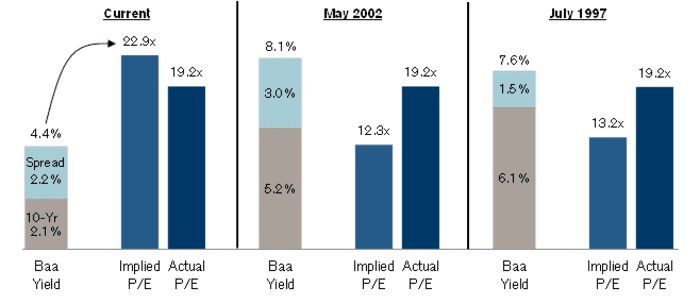2 + 2 still equals 4.
That’s the rough math behind a bullish case for stocks outlined by Credit Suisse’s Jonathan Golub, chief U.S. equity strategist, in a Monday client note.
To illustrate his point, Golub took the biggest BBB bracket of U.S. companies with investment-grade credit ratings and outlined why current 2.2% bond spreads, plus the roughly 2.1% yield on 10-year Treasury TMUBMUSD10Y, 2.318% rate, still make for a historically low 4.4% borrowing cost, (see chart) a positive for stock valuations.

Even at 4.4%, borrowing costs are pretty cheap for most big, public U.S. companies.
Credit Suisse
Golub compared two other dates in the past 25 years when stock multiples, calculated as a price-to-earnings ratio, were pegged at 19.2x. Back in May 2002 and July 1997, borrowing costs were around 8%.
That cost includes the spread, or premium above risk-free rates, that helps compensate investors for default risks. Spreads on BBB corporate bonds have climbed to about 2% in March from about 1% in 2021, plus the Treasury rate.
In short, most public companies can still borrow at historically low costs, even though the Federal Reserve last week started lifting it benchmark rate for the first time since 2018, while penciling in a series of more increases to come.
“Surprisingly, the cost of capital is dramatically lower today than in these comparable periods, supporting the argument that stocks are more attractively valued today,” Golub wrote.
More broadly, the Credit Suisse strategist also expects monetary policy to “remain too accommodative” relative to the pace of economic growth, a backdrop he views as supportive for stock prices.
Federal Reserve Chairman Jerome Powell on Monday didn’t rule out raising the federal-funds rate in increments of more than 25 basis points this year to help tackle inflation at 40-year highs, in remarks to the National Association for Business Economics.
Stocks fell after Powell’s remarks, giving up earlier gains, with the Dow Jones Industrial Average DJIA, -0.92% off more than 300 points and the S&P 500 index SPX, -0.45% lower by about 0.7%, despite its energy component surging 3.5% as U.S. oil prices CL00, +7.37% climbed to $ 110 a barrel.
